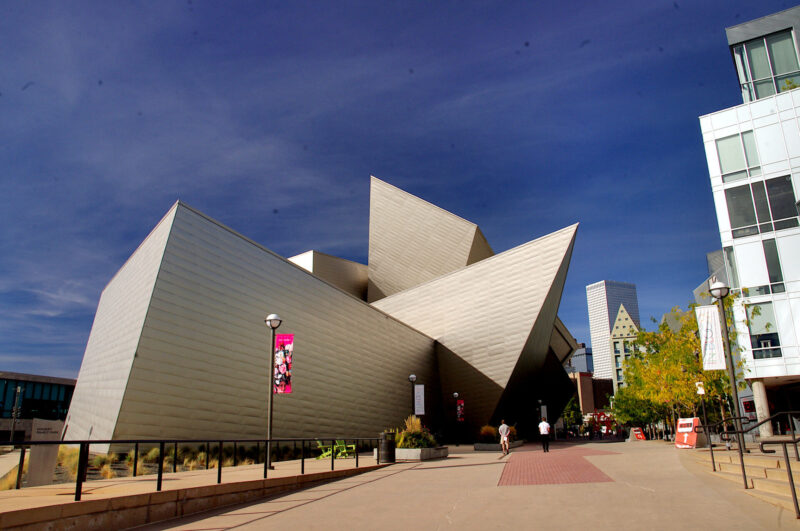How Denver Art Museum workers shape the future of cultural labor
08 May 2025 – John Fulton
Editor’s Note: This post is part of a 2025 History@Work series authored by members of the NCPH Labor Task Force in response to our Special Open Call on “#Advocacy in the Field”. You can read each post as it’s published throughout the year under H@W‘s #Advocacy tag.

Denver Art Museum (DAM), October 10, 2015. Photo credit: Jan Helebrant CC0 1.0 Universal
After a difficult campaign, the Denver Art Museum became the first art museum in Colorado to unionize in March 2024. Like other cultural institutions around the country, Denver Art Museum (DAM) employees face low pay, long hours, and limited job security. Unionization is a win for cultural employees struggling for better conditions at work. DAM employees have inspired many of us around the country.
As of January 2025, DAM has over 440 employees. But how is this workforce being treated? Denver’s cost of living keeps increasing as its population grows, and average pay at the DAM has not kept up.
“I have seen the drive and passion my colleagues have had for the DAM, but had to leave due to low pay, lack of career advancement, and their voices not being listened to,” Associate II Anaid Rivas Pastrana says on the DAM Workers United website.
UNION PUSH
Colorado is a right-to-work state. Right-to-work laws prohibit mandatory union membership and dues. These laws deprive unions of the funding they need to enforce the terms of contracts and ensure the fair treatment of workers.
The Denver Art Museum Workers Union’s (DAMWU) unionization effort publicly began in January 2024. Their main challenge was intense anti-union activity from upper management, leading to unfair labor practice (ULP) charges alleging threats against workers. DAM allegedly also offered benefits to employees willing to go against unionization, which is illegal. Despite these obstacles, the DAM Workers Union “won their union election on March 7, 2024, with a supermajority of 67% voting to join forces with American Federation of State, County & Municipal Employees (AFSCME) Council 18.”
HOW TO ORGANIZE
Unionization is a legal right with a defined process. In the United States, the National Labor Relations Act (NLRA) sets the federal process for private-sector unionization. Workers have the legal right to organize regardless of employer wishes. The process typically involves collecting signed authorization cards from 30% of employees, filing for an election with the National Labor Relations Board (NLRB), and winning a majority vote among eligible employees.
Museum employees who are interested in unionizing their workplace may wonder how to get started.
1) Unionization usually starts with one-on-one conversations among employees about poor working conditions. When enough people decide to make an attempt, to change the situation, unionization can be one, but not the only, choice for change.
2) Workers research and contact unions that can represent them. AFSCME, the International Union of Operating Engineers (IUOE), and the United Auto Workers are three larger organizations that represent museum workers. There are more focused independent unions, like the security guards who formed their own union at the Frye Art Museum in Seattle.
3) After selecting a union, workers file for an election with the NLRB. Eligible workers show their support by signing authorization cards and the NLRB checks these cards to verify that at least 30% of eligible employees want the union—that’s the minimum threshold required for an election to happen. After that, the NLRB conducts a confidential ballot election and certifies the vote’s results.
NEXT STEPS
After voting for a union, several things need to happen. First, a team of unionized workers start negotiating a contract with museum management. The union will then train staff to be stewards who will serve as leaders among the membership. The union will also establish a formal grievance process that gives staff a structured way to address workplace issues.
“Being a part of something bigger than myself feels exciting. To know that I have the power to bring change for the better towards my amazing coworkers is very inspiring,” Gallery Host Felicity Peckman said after the vote on March 7, 2024.
As of August 13, 2024, DAM Workers United reported on Instagram that contract negotiations had officially begun. At the one year anniversary of their union vote, March 7, 2025, the DAMWU was preparing for a second, security clause, election required by Colorado’s right-to-work law to determine if all employees either join the union or pay representation fees.
DAM’s successful unionization effort provides an example for public historians, especially in spite of Colorado’s right-to-work restrictions. This is a watershed moment in the state’s cultural labor history. It demonstrates how labor organizing can succeed even within legally restrictive environments and shows how cultural professionals are responding to sector-wide challenges like declining authority and unstable working conditions.
Labor movements within cultural institutions become part of the larger ongoing conversation in public history about who gets to interpret history and culture and under what conditions. The power dynamics within cultural institutions are hierarchical. Labor movements raise questions about the conditions under which history and culture are presented—i.e., are these conditions equitable, do they allow for diverse perspectives, and are the workers who maintain and present this history treated fairly? In essence, labor movements in cultural spaces are a struggle over the control of historical narratives and the conditions under which those narratives are produced and presented to the public.
~John Fulton is a museum worker who helped organize the Minnesota Historical Society in 2022. He draws from personal experience in the growing movement to unionize cultural institutions. His Bluesky handle is: @5amjournal.bsky.social



